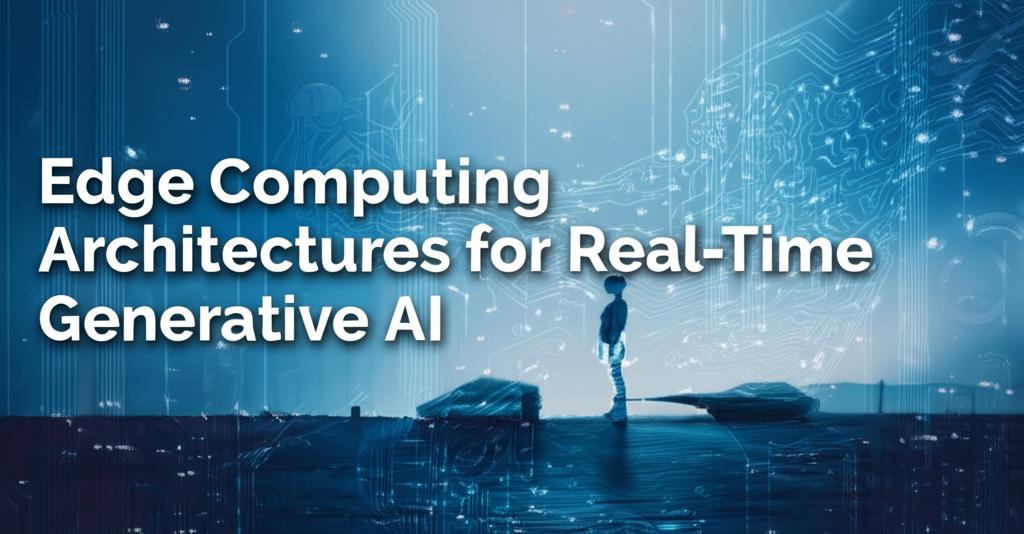The convergence of generative AI and edge computing is paving the way for innovative applications that demand real-time processing, low latency, and enhanced privacy. Running these complex AI models directly on edge devices, closer to where data is generated, offers significant advantages over traditional cloud-centric approaches. However, deploying generative AI on resource-constrained edge devices presents unique architectural and operational challenges.
At its core, edge computing in this context involves a decentralized paradigm where data processing occurs nearer to the data source. This minimizes latency, reduces bandwidth consumption, and can enhance data security and privacy by keeping sensitive information localized. For generative AI, this means the ability to create novel content (text, images, audio, etc.) in real-time, directly on devices like smartphones, autonomous vehicles, industrial robots, and healthcare monitors.
Key Architectural Considerations and Strategies:Successfully deploying real-time generative AI at the edge requires careful architectural planning, focusing on several key areas:
- Model Optimization: Generative AI models, particularly Large Language Models (LLMs), are notoriously large and computationally intensive. To make them suitable for the edge, various optimization techniques are crucial:
Model Pruning: Removing redundant or non-essential parameters and components from the model to reduce its size and complexity.
Quantization: Reducing the numerical precision of the model's weights and activations (e.g., from 32-bit floating point to 8-bit integer), which shrinks model size and can speed up computation, sometimes with specialized hardware support.
Knowledge Distillation: Training a smaller "student" model to mimic the behavior of a larger, more complex "teacher" model. This allows the smaller model to retain much of the performance of the larger one while being more efficient for edge deployment.
Architectural Redesign: Developing novel model architectures specifically designed for resource-constrained environments. This can include modified attention mechanisms and conditional computation. Neural Architecture Search (NAS) can also be employed to discover optimal, efficient model structures.
- Hardware Acceleration: Specialized hardware is often necessary to achieve real-time performance for generative AI on edge devices. This includes:
Edge AI Processors and NPUs (Neural Processing Units): Chips designed specifically to accelerate AI computations efficiently. Companies are developing low-power AI processors capable of handling transformer-based models.
GPUs (Graphics Processing Units) and CPUs (Central Processing Units): While more general-purpose, they can still play a role, though power consumption can be a concern for battery-operated devices.
Neuromorphic Chips: An emerging technology inspired by the human brain's neural structure, promising efficient real-time processing of sensory data with low power consumption.
- Software Frameworks and Toolchains: Robust software tools are essential for optimizing, deploying, and managing generative AI models on diverse edge hardware. Frameworks like TensorFlow Lite, ONNX, and solutions provided by hardware vendors (e.g., NVIDIA Jetson) facilitate this process. Lightweight Kubernetes distributions (like K3s) can be used for orchestrating containerized AI deployments on edge devices.
- Distributed and Hybrid Approaches:
Federated Learning: Training a global model across multiple decentralized edge devices without sharing raw data, thus preserving privacy and distributing the computational load.
Split Computing/Learning: Different parts of an AI model are run on different devices (e.g., some on the edge device, some on a nearby edge server, or in the cloud). This can balance an application's workload between edge and cloud resources.
Hybrid Cloud-Edge Models: Tasks are strategically split between edge devices and the cloud, leveraging the strengths of both. For example, real-time inference might happen at the edge, while more intensive model training or updates occur in the cloud.
- Data Management and Orchestration: Efficiently managing data pipelines, from data ingestion at the edge to processing and potential synchronization with the cloud, is critical. Intelligent workload orchestration can optimize resource utilization across distributed edge nodes. Adaptive caching mechanisms can also enhance performance.
Despite the advancements, several challenges remain:
- Resource Constraints: Edge devices inherently have limited processing power, memory, storage, and energy supply compared to cloud servers. Deploying large models like a full-precision Llama2-7B, which requires substantial memory, is often unfeasible on most current edge devices.
- Latency and Bandwidth: While edge computing aims to reduce latency, achieving the ultra-low latency required for true real-time generative AI applications can still be demanding. Unstable or limited connectivity in some edge environments can also pose a problem.
- Model Compatibility and Deployment Complexity: Ensuring that optimized models run efficiently across diverse edge hardware and platforms is a significant hurdle. The deployment and management of these systems can be complex.
- Security and Privacy: While edge processing can enhance privacy by keeping data local, security of the edge devices themselves and the AI models running on them is paramount.
- Maintaining Model Accuracy: Optimization techniques like pruning and quantization can sometimes lead to a degradation in model performance or accuracy. Finding the right balance is key.
The field is rapidly evolving. Researchers and engineers are continuously developing more lightweight and efficient AI model architectures (e.g., MobileNet, EfficientNet, TinyML). Advances in 5G and future 6G networks are expected to provide improved connectivity, further enabling distributed AI capabilities. Edge AI testbeds are becoming crucial for validating the feasibility of real-time, distributed intelligence. The trend is towards AI chips that can execute generative AI models directly at the edge, with increasing integration into PCs, smartphones, and other devices.
The synergy between generative AI and edge computing is poised to unlock a new generation of intelligent, responsive, and personalized applications across various industries, including autonomous driving, smart cities, healthcare, retail, and manufacturing. As hardware becomes more powerful and model optimization techniques more sophisticated, the capabilities of real-time generative AI at the edge will continue to expand.

